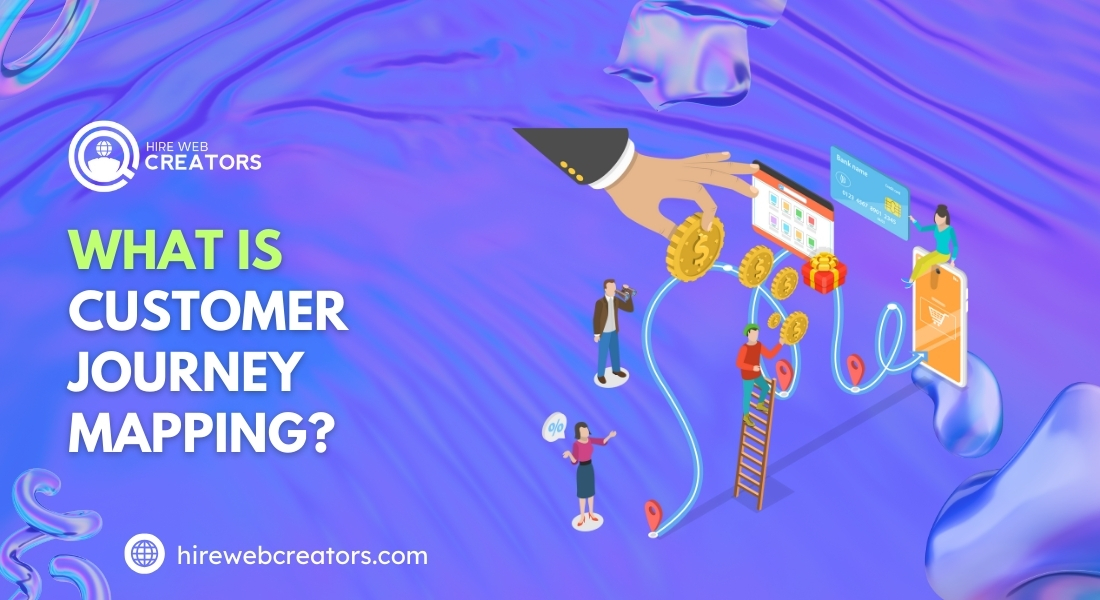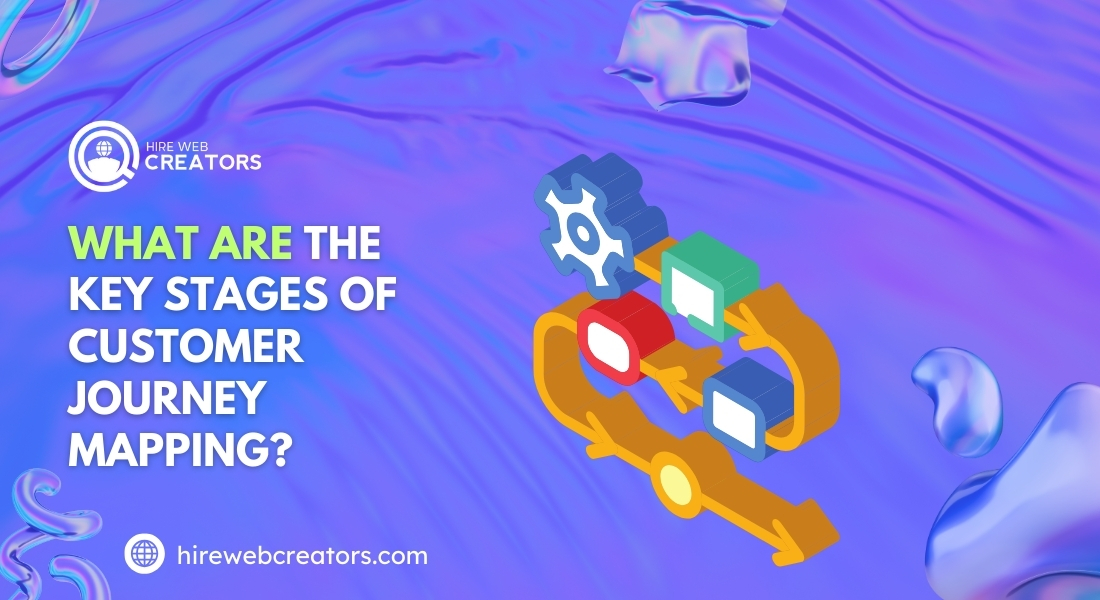

Customer Journey Mapping: 11 Powerful Tips for B2B Success
Discover the vital role of customer journey mapping in B2B web development. Unlock insights to enhance user experience and drive conversions!
In the fiercely competitive B2B environment, customer journey mapping can help shape a website that is not visited by potential customers but engenders lifelong clients. Customer journey mapping allows businesses to see the overview of how prospects experience or engage with a brand at every touchpoint. Hence, companies could imagine the journey and detect problem areas, improve the user experience, and design the web development strategy according to the particular needs of their audience.
Customer journey mapping assumes great importance in the B2B digital-age landscape. This provides an opportunity for companies to come up with customized experiences where each interaction connects to the target customer. The more time invested in understanding the paths of customers, the more that will build an organization in terms of better relationships and engaging them toward improved growth in the fast-moving digital marketplace.
What is Customer Journey Mapping?
Customer journey mapping is a strategic process that visualizes the steps a customer takes when interacting with a brand. This methodology allows organizations to understand and analyze the experiences of their customers across various touchpoints, from initial awareness to post-purchase evaluations. By mapping these journeys, businesses can gain valuable insights into customer behavior, preferences, and pain points, enabling them to create more effective marketing strategies and web development solutions.

Key elements of customer journey mapping include:
- Stages of the Journey: The journey is often divided into several stages, such as awareness, consideration, decision-making, and retention. Understanding each phase helps businesses identify the key interactions customers have with their brands.
- Customer Emotions: Mapping also considers the emotions customers experience at each stage. Recognizing feelings such as frustration or satisfaction can provide valuable information for improving user experience.
- Touchpoints: These are the various points of interaction between the customer and the business, including websites, social media, customer service, and email communications. Identifying these touchpoints is essential for optimizing the overall customer journey.
In the context of B2B web development, customer journey mapping serves as a powerful tool for designing websites that cater to the needs and expectations of target audiences. By employing this approach, organizations can ensure their web presence is aligned with the behaviors and preferences of their customers. This alignment not only enhances user experience but also fosters trust and loyalty, ultimately leading to higher conversion rates.
Why is Customer Journey Mapping Important?
Customer journey mapping is crucial for businesses aiming to thrive in the competitive B2B landscape. By visualizing the customer experience, organizations can pinpoint inefficiencies and areas for improvement within their processes. This understanding allows businesses to address customer pain points proactively, leading to enhanced satisfaction and loyalty. When companies invest in customer journey mapping, they lay the groundwork for a more customer-centric approach that resonates with their target audience.
Implementing customer journey mapping also facilitates better alignment between marketing and sales teams. When both departments understand the customer’s journey, they can collaborate more effectively to deliver tailored messages and solutions. This alignment ensures that marketing efforts resonate with potential clients at every stage of the journey, from awareness to decision-making. As a result, organizations can optimize their resources and drive higher engagement rates.
Another significant benefit of customer journey mapping is its ability to enhance data-driven decision-making. By analyzing customer interactions and feedback, businesses can gain valuable insights into preferences and behaviors. These insights enable organizations to make informed decisions that improve website design and user experience. Emphasizing customer journey mapping not only empowers businesses to create effective strategies but also fosters a culture of continuous improvement, ultimately leading to sustained growth in a rapidly evolving marketplace.
How Does Customer Journey Mapping Benefit B2B?
Customer journey mapping offers numerous benefits for B2B companies seeking to improve their web development strategies. By clearly defining the customer journey, organizations can identify critical touchpoints where customers interact with their brand. This understanding helps businesses create a seamless experience across all platforms, enhancing customer satisfaction and loyalty. When companies focus on optimizing these interactions, they can significantly improve conversion rates and overall performance.

One of the primary benefits of customer journey mapping is its ability to highlight gaps in the customer experience. By examining each stage of the journey, businesses can pinpoint areas where customers may encounter obstacles or frustrations. Addressing these issues can lead to a smoother experience and increase the likelihood of repeat business. Additionally, businesses can tailor their messaging and offerings to meet the specific needs of customers at different journey stages.
Another significant advantage of customer journey mapping is its role in fostering deeper customer relationships. By understanding the emotions and motivations behind customer interactions, B2B companies can develop more personalized experiences. This personalized approach not only enhances customer engagement but also builds trust and credibility. As businesses invest in customer journey mapping, they cultivate stronger relationships that lead to long-term loyalty and advocacy.
What Are the Key Stages of Customer Journey Mapping?
Customer journey mapping typically consists of several key stages that outline the customer’s experience. Understanding these stages is essential for B2B companies aiming to create effective web development strategies. The first stage is awareness, where potential customers become familiar with a brand or product. In this phase, marketing efforts play a vital role in capturing attention and generating interest.

The next stage is a consideration, where customers actively evaluate different options. During this time, organizations should focus on providing relevant information and resources that address customer needs. This could include case studies, product demos, or informative content that highlights the value of the offering. Ensuring that potential customers have access to the right information during this stage is crucial for guiding them toward a decision.
The decision-making stage follows, where customers choose a product or service. Effective customer journey mapping allows businesses to create a streamlined process that facilitates this decision. Providing clear calls to action, easy navigation, and persuasive content can significantly impact conversion rates. Finally, the retention stage focuses on keeping customers engaged post-purchase. Here, organizations should implement strategies to nurture relationships and encourage repeat business, ensuring that customers feel valued and satisfied.
How to Create an Effective Customer Journey Map?
Creating an effective customer journey map requires a structured approach that takes into account various factors influencing the customer experience. The first step is to define the customer personas relevant to the business. Understanding the unique characteristics, needs, and pain points of each persona allows organizations to tailor their mapping process. By identifying who the customers are, businesses can create more relevant and impactful journey maps.
Next, businesses should outline the stages of the customer journey. This involves mapping out the key touchpoints, interactions, and emotions experienced by customers at each stage. Engaging stakeholders from different departments, such as marketing, sales, and customer service, can provide valuable insights into the journey. Collaborating with team members ensures that all perspectives are considered and helps create a comprehensive view of the customer experience.
After mapping the stages, organizations should analyze the data collected during the mapping process. Identifying patterns and trends within the customer journey can uncover opportunities for improvement. Using this information, businesses can develop actionable strategies to enhance the overall experience. By incorporating Minimalist Web Design principles, companies can create a streamlined and intuitive interface that improves user engagement. By continuously refining the customer journey map based on feedback and performance metrics, B2B companies can stay aligned with their customers’ evolving needs and preferences.
What Tools Can Help in Customer Journey Mapping?
Utilizing the right tools can significantly enhance the customer journey mapping process. Various software solutions are available that help businesses visualize and analyze the customer experience. One popular option is journey mapping software, which allows organizations to create visual representations of customer journeys. These tools often include features such as templates, collaboration capabilities, and analytics to streamline the mapping process.

Another useful tool for customer journey mapping is customer feedback platforms. These platforms enable organizations to gather valuable insights directly from customers through surveys, interviews, and focus groups. By collecting feedback, businesses can better understand the customer experience and identify areas for improvement. Integrating customer feedback into the mapping process ensures that organizations remain responsive to their audience’s needs.
Data analytics tools also play a crucial role in customer journey mapping. By analyzing user behavior and interactions on websites, businesses can gain insights into how customers navigate their journey. These analytics can reveal valuable information about drop-off points, engagement levels, and conversion rates. Combining journey mapping software with data analytics tools creates a robust approach that enables B2B companies to optimize their web development strategies effectively.
How to Analyze Customer Journey Data?
Analyzing customer journey data is essential for identifying opportunities to enhance the customer experience. The first step is to gather data from various sources, including website analytics, customer feedback, and sales records. This comprehensive data collection allows businesses to create a holistic view of customer interactions. By compiling this information, organizations can identify trends and patterns that inform their strategies.

Next, businesses should focus on segmenting the data based on customer personas and journey stages. This segmentation enables organizations to understand the unique experiences of different customer groups. By analyzing the journey data for specific segments, businesses can uncover insights that drive targeted improvements. This approach helps ensure that strategies are tailored to meet the needs of diverse audiences.
Finally, organizations should prioritize the insights gathered from the analysis. Identifying key areas for improvement allows businesses to focus their efforts on the most impactful changes. Implementing data-driven strategies not only enhances customer satisfaction but also supports long-term growth. By continually analyzing customer journey data, B2B companies can adapt their web development efforts to stay aligned with customer expectations and preferences.
What Common Mistakes to Avoid in Journey Mapping?
When implementing customer journey mapping, businesses should be aware of common pitfalls that can hinder the effectiveness of the process. One significant mistake is failing to involve key stakeholders from different departments. Collaborating with marketing, sales, and customer service teams is essential for creating a comprehensive journey map. Without input from diverse perspectives, organizations may overlook critical touchpoints and customer needs.
Another common error is relying solely on assumptions rather than data. While intuition can be valuable, basing decisions on actual customer behavior and feedback is crucial for effective journey mapping. Businesses should prioritize data collection and analysis to inform their strategies. By grounding decisions in real insights, organizations can create more accurate and impactful journey maps.
A third mistake is neglecting to update the customer journey map regularly. As customer preferences and behaviors evolve, businesses must adapt their strategies accordingly. Failing to revisit and revise the map can lead to outdated practices that no longer resonate with customers. By committing to continuous improvement and regularly updating the journey map, B2B companies can ensure their web development efforts remain relevant and effective.
How Does Customer Journey Mapping Impact User Experience?
Customer journey mapping significantly impacts user experience by providing a comprehensive view of the customer’s interactions with a brand. By mapping out these interactions, businesses can identify pain points and opportunities for improvement. Understanding the customer’s journey allows for the creation of seamless and intuitive experiences, leading to higher satisfaction and loyalty. When each touchpoint is optimized, the overall user experience is enhanced, resulting in a positive perception of the brand.
- Customer journey mapping identifies key pain points
- Enhances seamless interactions
- Improves overall user satisfaction
By leveraging customer journey mapping, businesses can tailor their web development efforts to meet the specific needs and preferences of their users. This targeted approach ensures that each stage of the journey is optimized, reducing friction and increasing engagement. When users encounter a well-designed and intuitive interface, they are more likely to complete their desired actions, whether it’s making a purchase, filling out a form, or contacting support. This leads to improved conversion rates and a more positive user experience.
- Tailors web development to user needs
- Reduces friction and increases engagement
- This leads to higher conversion rates
Customer journey mapping also helps in personalizing the user experience. By understanding the unique paths taken by different segments of customers, businesses can create customized experiences that resonate with their audience. Personalized experiences are more engaging and relevant, making users feel valued and understood. This level of personalization not only enhances user satisfaction but also drives long-term loyalty and advocacy.
- Facilitates personalized user experiences
- Engages and resonates with the audience
- Drives loyalty and advocacy
How Does Customer Journey Mapping Improve User Experience?
Customer journey mapping plays a vital role in enhancing user experience by providing insights into customer behavior and preferences. By visualizing the customer journey, organizations can identify pain points and areas where users may struggle. Addressing these challenges not only improves the overall experience but also fosters greater customer satisfaction. When businesses focus on optimizing user experience, they create a more seamless and enjoyable interaction with their brand.
Moreover, customer journey mapping enables businesses to deliver more personalized experiences. Understanding the emotions and motivations behind customer interactions allows organizations to tailor their offerings and messaging to meet specific needs. By providing relevant content and resources at each stage of the journey, businesses can engage customers more effectively. This personalized approach helps build trust and loyalty, resulting in stronger relationships.
In addition, customer journey mapping facilitates better communication between departments. When marketing, sales, and customer service teams share a common understanding of the customer journey, they can collaborate more effectively. This alignment ensures that all touchpoints are consistent and aligned with customer expectations. By enhancing collaboration and communication, B2B companies can create a more cohesive user experience that resonates with their audience.
What Are the Key Elements of Effective Customer Journey Mapping?
Effective customer journey mapping involves several key elements that ensure a comprehensive and accurate representation of the customer experience. One of the most important elements is identifying and understanding customer personas. These personas represent different segments of the customer base, each with unique needs, behaviors, and pain points. By defining these personas, businesses can tailor their journey maps to address the specific experiences of each group.
- Identifying customer personas
- Understanding unique needs and behaviors
- Tailoring journey maps for each persona
Another crucial element is mapping out all the touchpoints a customer interacts with during their journey. This includes every interaction, from initial awareness and consideration to post-purchase support and feedback. By documenting each touchpoint, businesses can gain a holistic view of the customer experience and identify areas for improvement. This comprehensive mapping ensures no aspect of the journey is overlooked, leading to more effective optimizations.
- Mapping all customer touchpoints
- Gaining a holistic view of the experience
- Identifying areas for improvement
Gathering and analyzing data is also essential for effective customer journey mapping. This data can come from various sources, including website analytics, customer feedback, and sales records. Analyzing this data provides insights into customer behavior, preferences, and pain points. These insights inform the journey mapping process, ensuring that the maps are based on real, actionable data rather than assumptions. This data-driven approach leads to more accurate and effective journey maps.
- Gathering data from multiple sources
- Analyzing customer behavior and preferences
- Ensuring data-driven journey maps
What Role Does Customer Journey Mapping Play in B2B Web Development?
Customer journey mapping plays a crucial role in B2B web development by informing design and functionality decisions. By understanding the customer journey, businesses can create websites that cater to user needs and preferences. This user-centric approach ensures that the website effectively guides potential customers through each stage of their journey, from awareness to decision-making.

Incorporating customer journey insights into web development also enables organizations to optimize their content strategy. By analyzing customer interactions, businesses can identify which types of content resonate most with their audience. This understanding allows organizations to create targeted resources that address customer pain points and support their decision-making process. Effective content strategy, aligned with the customer journey, enhances user engagement and satisfaction.
Customer journey mapping supports the implementation of effective calls to action (CTAs) on the website. Understanding where customers are in their journey allows businesses to strategically place CTAs that encourage users to take the next step. Whether it’s signing up for a newsletter, requesting a demo, or making a purchase, well-placed CTAs can significantly improve conversion rates. By prioritizing customer journey mapping in B2B web development, organizations can create websites that drive results and foster lasting relationships.
How to Integrate Customer Journey Insights into Your Strategy?
Integrating customer journey insights into business strategy involves a systematic approach that ensures alignment with customer needs. The first step is to communicate the findings from the customer journey mapping process to all relevant stakeholders. By sharing insights across departments, organizations can create a unified understanding of customer expectations and pain points. This collaboration fosters a customer-centric culture that prioritizes enhancing the overall experience.
Next, businesses should prioritize actionable changes based on the insights gathered. Identifying key areas for improvement and developing specific strategies to address them is essential. This could involve optimizing website design, refining marketing messaging, or enhancing customer service processes. By focusing on targeted improvements, organizations can create a more streamlined experience that resonates with customers.
In conclusion, customer journey mapping is an essential strategy for B2B companies looking to enhance their web development efforts and improve overall customer experience. By understanding the various stages of the customer journey, organizations can identify key touchpoints, optimize interactions, and address pain points that may hinder satisfaction. The insights gained from this process enable businesses to create more personalized experiences that resonate with their target audience, ultimately fostering trust and loyalty.
As the digital landscape continues to evolve, the importance of customer journey mapping will only grow. Companies that invest in this strategic approach will be better equipped to adapt to changing customer expectations and preferences. By integrating customer journey insights into their overall strategy, B2B organizations can drive engagement, improve conversion rates, and establish lasting relationships with clients. Emphasizing customer journey mapping not only enhances user experience but also positions businesses for long-term success in a competitive marketplace.
